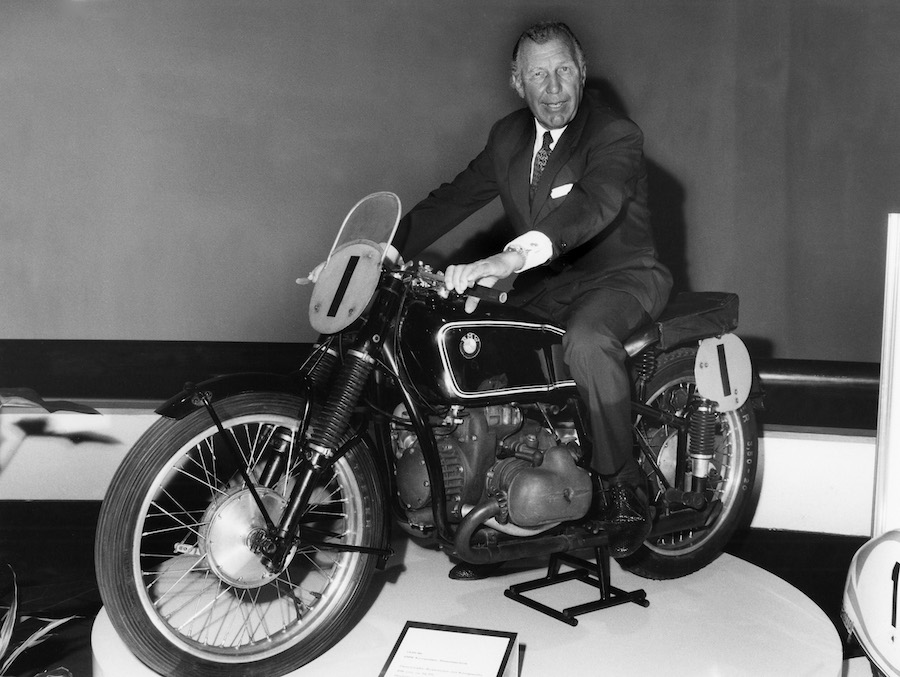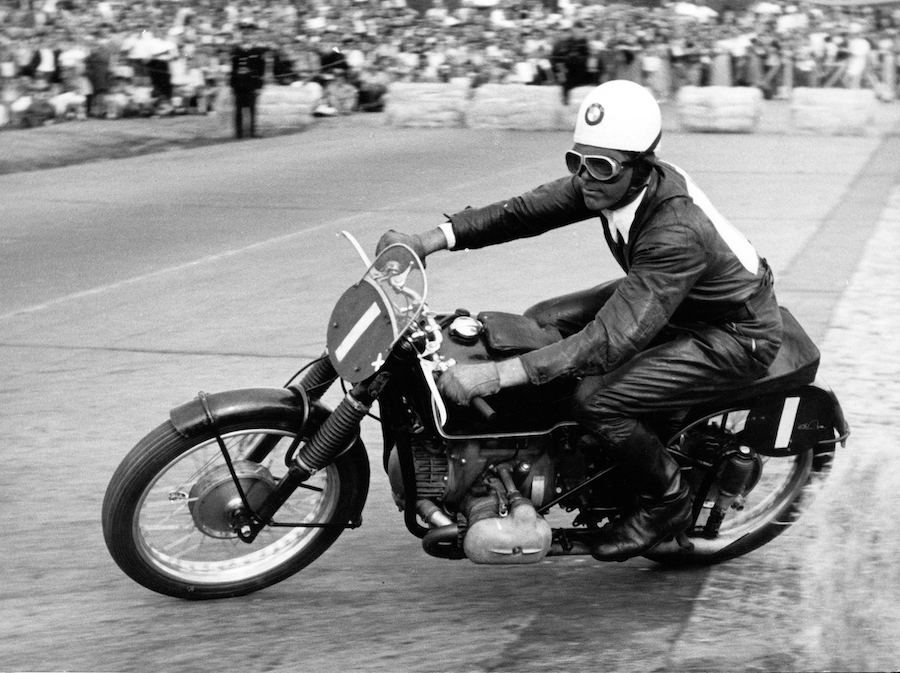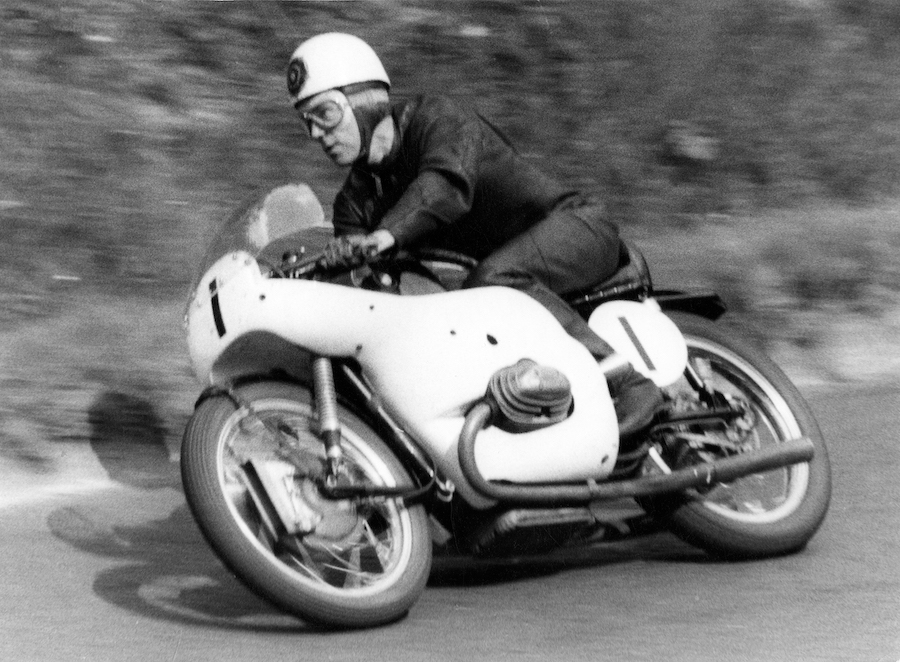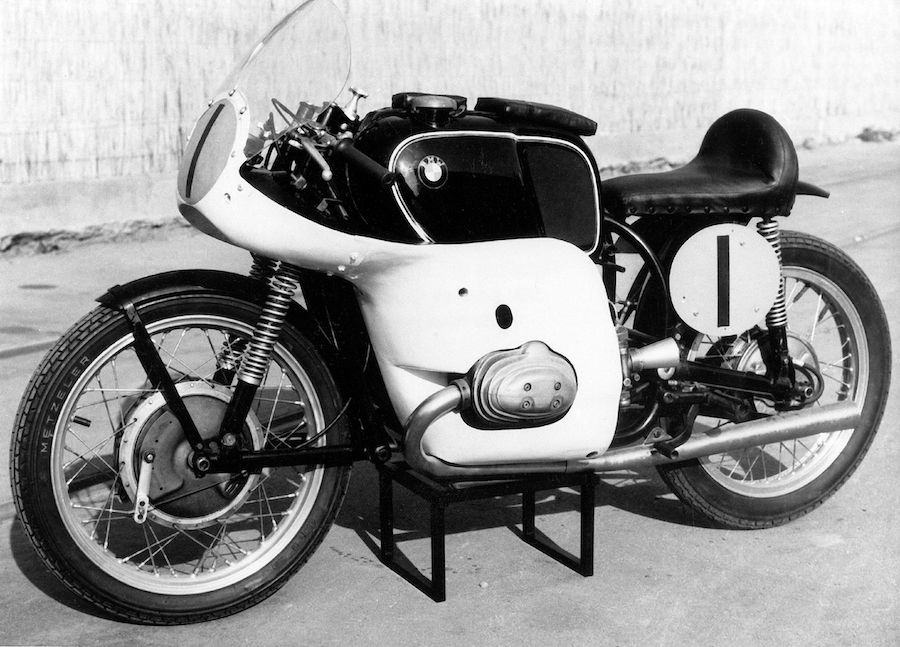Eighty years ago Georg Meier won the 1939 Senior TT on the Isle of Man on what’s regarded today as a rather extraordinary motorcycle
In the middle of the 1930s, BMW surprised friend and enemy when it introduced its newest racer, a supercharged boxer twin. The black machine didn’t appear all that threatening, but a 28-year-old Bavarian named Georg ‘Schorsch’ Meier entered the BMW factory racing team in 1937 and it all changed. BMW quickly became a force to be reckoned with in international GP racing, this led to a prestigious European Championship title in 1938 and a year later, a highly coveted victory in the Isle of Man 500cc Senior TT. The two most important titles in motorcycle racing at the time, and when combined, had the same status as a world championship.
As part of the nationalist propaganda campaign in the 1930s, German automotive factories were urged to participate more actively in racing and thus highlighting the technical capabilities of Germany’s new National Socialistic regime at the time. BMW picked up the gauntlet and developed a new, 500cc supercharged boxer racer. It would be the forerunner of an impressive series of GP racers that followed.The BMW Type 255 RS500 Kompressor debuted at Berlin’s famous Avus circuit in 1935 in the capable hands of Ludwig ‘Wiggerl’ Kraus.
As impressive as it was, Wiggerl didn’t win. The race was won by Ragnar Sunqvist on the new 500cc Husqvarna V-twin, with an average speed of 170km/h, impressive for the mid-1930s. The Kompressor’s maiden victory came in the International Six Days Trial that same year, when Wiggerl and swinger Hermann Paul Müller rode to victory ahead of BMW solo works riders Meier and Jospeh Stelzer.
In 1936 BMW work riders Otto Ley and Karl Gall also campaigned GP races with the 500 Kompressor. Ley finished second behind Norton works rider Jimmie Guthrie in the Swiss Grand Prix. The naturally aspirated Norton single was a great handler and Guthrie knew how to exploit it. Even though the Kompressor was much more powerful, it was also much heavier and didn’t handle as well.

Georg Meier in 1958 on his 1939 TT winner
Ley again finished second during the 1936 Dutch TT, but it was in Sweden where the Kompressor would celebrate its first road race win. In fact, Ley and Gall managed to book a 1-2 finish against the fierce competition of the works machines of Norton, DKW, Moto Guzzi and FN.
In the same period, BMW lost a number of world records again to Brough Superior and its factory rider Eric Fernihough. The German marque wanted them back and asked Rudolf Schleicher to prepare a Kompressor capable of such a feat. Schleicher was also a gifted racer who had won many race successes for the Bavarian brand. It wouldn’t take long or a fully streamlined 500cc Kompressor was presented to an eager public and ready to undertake a serious world-record breaking attempt.
On October 12, 1936 Ernst Henne broke an impressive string of world records on the Autobahn between the cities of Frankfurt am Main and Darmstadt. Henne managed to propel his projectile to a speed of 272.006km/h! It was a dangerous achievement – the streamlined Kompressor became unstable at speeds above 250km/h. Later on, an aerodynamic study was conducted and found that if the machine reached 280km/h it could no longer be considered ridable…
In road-race trim, the 500 Kompressor could deliver a hefty 80hp at 8000rpm. Charging could be adjusted with added pressure between 0.4 and 2 bar, most times they were adjusted for reliability to deliver a power output between 50hp (at 6500rpm) and 60hp (at 7000rpm). Its power output was enough to propel the 138kg (dry) bike to a top speed of over 225km/h, delivering more than crisp acceleration in the process.
In 1937 a new version of the Kompressor was introduced. Mechanically the same, the chassis was new and it received new rear plunger-type suspension which was the work of BMW’s Alexander von Falkenhausen. It was received with mixed feelings by the works riders, with many not convinced the new frame would be rigid enough to cope with the powerful Kompressor engine. To prove its suitability, Van Falkenhausen entered a BMW works team equipped with fully sprung bikes in the International Six Days Trial. It was a brave decision, British bikes were considered unbeatable in the terrain and their riders were true off-road specialists. The fully sprung BMWs performed remarkably well, coming within 10 seconds from the win. Moe importantly, their performance was enough earn the trust of the riders.
- BMW RS 500 Rennsport Kompressor & Georg Meier – Schotten 1947
- AHERLINC BMWRF3558_1 unique 600cc Kompressor Zeller goodbye present
It wasn’t just the trails it was successful in, its handling was improved over the previous version and it had far less issues taking on the quick-handling British singles and the accolades followed. Gall won the 500cc Dutch TT, followed by a victory on the Sachsenring during the German Grand Prix. It was the first German GP for BMW since Hans Soenius won the event in 1929, though sadly the event was overshadowed by the accident which took the life of Norton works rider Jimmie Guthrie.
Otto Ley won the Swiss Grand Prix, followed by Jock West’s glorious victory in the Ulster Grand Prix – normally a happy hunting ground for the British works teams. At the end of 1937,BMW had won four of the seven grands prix. West had finished the 1937 Senior TT in sixth place, which BMW considered very promising – so decided enter the event with a bigger team in 1938 and aim for the win.
It was the most important race for BMW in 1938 and the Bavarian marque had three of their best riders entered in the Senior TT, Meier, Gall and West.
Because of the variation in altitude over the course, BMW had lower the Kompressor’s state of tune for a output capability of 55hp at 7000rpm, much less than its potential. With a 37.75mile-long Mountain Course, reliability was key.
Perhaps too hungry, 1938 wasn’t the success BMW had hoped for. Gall crashed in practice and was out of the race, a mechanic had stripped a thread in Meier’s cylinder head during a routine spark-plug change and while he started the race on one cylinder, was soon forced to retire. West had more luck, he managed to finish the race in fifth place behind eventual winner Harold Daniel on the 500cc Norton single.
Positive results came a few weeks later when West won the Ulster GP, Meier went onto win the Dutch TT, both the Belgian and German GP and, to top it off, clinched the most prestigious racing title of that time: the 500cc European Championship. Isle of Man TT win or not, it was still a superb year for the 500 Kompressor.
- Ignored Tags: $8649
When the threat of war increased in 1939, Norton pulled out of racing. This meant that the 500cc GP racing season would a battle between the liquid-cooled, supercharged four-cylinder Gilera Rondine and BMW’s Type 255 RS 500 Kompressor. Meier, Gall and West again traveled to the Isle of Man with a goal to claim the coveted Senior TT spoils.
Gall crashed again in practice, this time heavily at Ballaugh Bridge, and he succumbed to his injuries four days later in hospital. Despite the tragedy, or perhaps because of it, Meier rode the 500 Kompressor to a mind-blowing average speed of mph (143.81km/h) to claim the coveted win and West followed him home to secure an emotional 1-2 for BMW. By doing so, Meier became the first non-British rider to win a TT on a non-British motorcycle. At the time it was by far the most prestigious race in the world, a victory which carries the same weight as a world championship title today.
Still regarded today as one of BMW’s most famous and important road-racing victories, it was remarkable that Meier, still then very much a novice around the gruelling circuit, could be in contention for the win.
When asked after the secret of his success, Meier said: “riding here reminds me of riding in my beloved Bavarian Alps. Curve after curve, fast long straights followed by slow bends, flowing fast lines and tight hairpins. It just went smooth and almost automatic, I really enjoyed the race!”
Meier’s winning machine was weighed in after the race. With its low weight of 137kg it was the lightest machine in the field. A little-known fact was that Meier’s winning bike also featured an combined braking system. BMW had made it at Meier’s request, who had injured himself in a car crash not long before the race.
It wasn’t the only TT victory for Meier that year, as he also won the Dutch TT, followed a few weeks later with a victory in the Belgian GP at Spa Francorchamps. Again, it was an epic, and it was the first time a lap record above 100mph was recorded during a European grand prix. Meier crashed during the Swedish Grand Prix, causing him to sit out the German GP and which ultimately cost him his second European title. World War II broke out shortly after and all racing ceased.
After the war, German factories were forbidden to participate in GP racing, but in 1947 the ban was lifted. Rumour broke out that racing ace Meier and his Kompressor would front the start of the famous annual international race at the Solitude circuit near the city of Stuttgart in Southern Germany. A vast crowd showed up at Solitude, celebrating the lift of the racing ban and watched Meier dominate.
Development of the Kompressor resumed. and BMW began experimenting with ways to improve the output of the supercharger. A number of twin-stage supercharger were developed, more or less following the overall concept of a rotary engine’s epitrochoid movement. The engine slowly but surely became more and more refined and ultimately led to one of the most reliable engines in GP racing of that era.
BMW anticipated the ban of supercharging. After World War II, turbos and supercharging were no longer allowed in grand prix racing. Instigated by the British motorcycle industry, who didn’t have the resources to develop exotic and complex racers, they knew they would never be able to catch up with their German and Italian competitors.
At first, BMW wasn’t allowed to participate in the new 500cc Motorcycle Grand PriX World Championship introduced in 1949. A few years later it was welcome again, however its supercharged 500 Kompressor was banned for good.
BMW already had developed an naturally aspirated successor which performed well and, in sidecar form, it gained a long-held reputation as being unbeatable in the world championship. In solo form it was less successful, with its best result of runner-up in the 1956 500cc World Championship in the hands of Walter Zeller.
The lessons learned in developing the Kompressor and its naturally aspirated successors created a firm base for a long series of BMW production models which have followed. In fact, the four valve BMW boxer engines of today boast features that were once conceived for the pioneering and hugely successful Type 255 RS 500 Kompressor.
Words Ivar de Gier Photography Archives A. Herl & Ernst Henne














